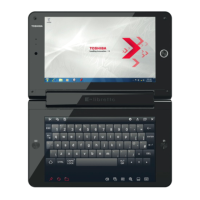
Do you have a question about the Toshiba Libretto W100 and is the answer not in the manual?
| Processor family | Intel® Pentium® |
|---|---|
| Processor frequency | 1.2 GHz |
| Processor manufacturer | Intel |
| GPS (satellite) | No |
| Motherboard chipset | - |
| HDD speed | - RPM |
| SSD capacity | The Solid State Drive's storage capacity in Gigabytes. |
| HDD interface | SATA |
| Card reader integrated | Yes |
| Total storage capacity | 62 GB |
| Compatible memory cards | MiniSDHC |
| Display diagonal | 7 \ |
| Display resolution | 1024 x 600 pixels |
| Native aspect ratio | 5:3 |
| Graphics card | HD Graphics |
| Dimensions (WxDxH) | 202 x 123 x 25.4 mm |
| Power requirements | 100–240V, 50/60Hz |
| Internal memory | 2 GB |
| Memory clock speed | 1066 MHz |
| Internal memory type | DDR3-SDRAM |
| Maximum graphics card memory | 2.024 GB |
| Audio system | Realtek ALC269Q-VB5-GR |
| Number of built-in speakers | 2 |
| Front camera resolution (numeric) | 1 MP |
| Bluetooth version | 2.1+EDR |
| Operating system installed | Windows 7 Home Premium |
| USB 2.0 ports quantity | 1 |
| VGA (D-Sub) ports quantity | 0 |
| Battery life (max) | - h |
| Number of battery cells | 8 |
| AC adapter power | 45 W |
| AC adapter frequency | 50 - 60 Hz |
| AC adapter input voltage | 100 - 240 V |
| AC adapter output current | 2.37 A |
| AC adapter output voltage | 19 V |
| Operating temperature (T-T) | 5 - 35 °C |
| Operating relative humidity (H-H) | 20 - 80 % |
| Certification | RoHS |
| Sustainability certificates | ENERGY STAR |
| Product type | Netbook |
| Product color | Black |
| Depth | 123 mm |
|---|---|
| Width | 202 mm |
| Height | 25.4 mm |
| Weight | 819 g |
Guides on creating recovery media for system restoration and data backup.
Guides on touch operation, screen management, virtual keyboard, and taskbar features.
Covers power conditions, status indicators, and monitoring battery charge.
Guides on battery types, charging, maintenance, maximizing life, and replacement.
Explains Shut Down, Sleep, and Hibernation modes and their settings.
Guides on configuring BIOS, password, boot priority, CPU, USB, and SATA settings via HW Setup.
Steps for identifying and resolving issues, including preliminary checks and problem analysis.
Addresses problems related to hardware, system startup, power, and overheating.
Solutions for AC power, battery, touch screen, storage, sound, and wireless device problems.